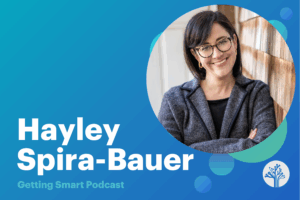How Teachers Use Paper Blogging to Promote Student Voice

With how much connected educators (myself included) refer to blogging with students as if it were a common practice in every classroom, it is easy to feel like yours is the only one without 1:1 devices or access to blogging websites. Though this is certainly not the case, a lack of infrastructure needn’t keep your students from engaging in the social learning and higher order thinking opportunities provided by posting and commenting on blogs. Paper blogging, as an offline alternative, is popular with teachers and students whether they have the means for digital publication or not. And to get started, you need little more than, well, paper.
Paper blogs are exactly that, blog entries written on paper. Ranging from a simple composition akin to a personal essay all the way to an analog replica of a blog platform’s user interface (with tag clouds, “plug-ins”, and more), paper blogging serves as an entry point to reflective writing, offline discussions about digital citizenship, and best of all, continuing conversations through commenting.
Unlike the comments thread of an online platform, paper blogging has students submit their comments by writing them on a Post-It Note and adhering them to blog entries. As the blogger responds to individual comments, he or she also utilizes a Post-It Note and adheres it to the bottom of note being responded to. Not only does this organize students’ conversations, it also focuses their thoughts.
Pernille Ripp, an elementary teacher and active classroom blogger uses paper blogs to get her students to share what they are most passionate about. “Using paper blogs to get my 5th graders to think about how to comment . . . and how to start a conversation with their comments is one of the essential things I do every year” says Ripp. “It has developed into something I love doing and find essential as we prepare to blog and converse with the world.”
The activity of paper blogging is just that, preparation for real world interactions. In 5 Reasons Your Students Should Blog, George Couros says, “Giving students a place to share their voice is extremely important. . .In a blog, you may learn a lot about not only what students are learning in school, but what they are passionate about and hopefully how we could serve them better as educators.” Couros goes on to ask, “In a world where everyone can have a voice, isn’t it essential that we teach students how to use this powerful medium to share theirs in a meaningful way?”
Blogging, both online and on paper, can do just that. And Leonord Lowe, an E-Learning Designer at the University of Canberra’s Teaching and Learning Centre, has a lesson plan to help teachers get started with their own paper blogging activities.
According to Lowe, “[Paper blogging] demonstrates what blogs are, how they work, and why they can be a powerful strategy for empowering and engaging learners.”
Rather than confining paper blogs to the classroom alone , Lowe actually uses paper blogging activities with teachers in professional development workshops. In his design, educators take 10 minutes to individually respond to a video clip that Lowe shows to start his session. As they do, they add keywords to reflect the theme of their responses. Once everyone has a blog post written, each of them meets with two other people to exchange their responses. While reading others’ blog posts, participants use Post-It Notes to add a comment for their colleague, eventually moving on to another classmate and another blog post.
However, during this activity, Lowe gets teachers thinking about the actual experience of publishing online content as well as digital citizenship by introducing spam. Using fluorescent pink Post-It Notes, Lowe has a designated spammer leave short unwelcomed comments in everyone’s comment thread. “Spam leaves you sitting there wondering what is going on and leaves you wondering what you can do about it.”
As teachers in Lowe’s paper blogging sessions retrieve their original blog posts and get back together as a class, they reflect on their posts and the new comments thread. Each is encouraged to ask themselves, Do you want to add anything? Delete anything? Has your thinking changed at all? And through identifying others with similar keywords as their own, Lowe’s paper bloggers get together and discuss these questions and their overall experience blogging.
Whether with teachers or students, paper blogging can be a very powerful, eye-opening experience. As Couros says, “Not every student will take to blogging the way that we envision as teachers . . . If we make them do it the way we think it should be done, they might have trouble adopting this past the school setting.” But as students and teachers are allowed and empowered to write about what they are interested in and what stokes their passions, paper blogs might eventually leap off the page. As students and teachers are encouraged and supported in writing their own blogs, they might even see the value in sharing their own voices whether digitally or on good old fashioned paper.







0 Comments
Leave a Comment
Your email address will not be published. All fields are required.